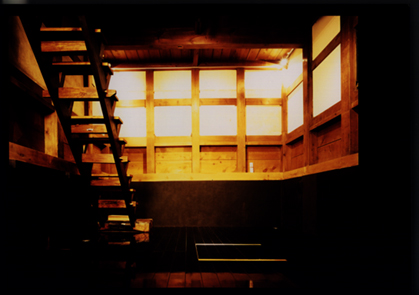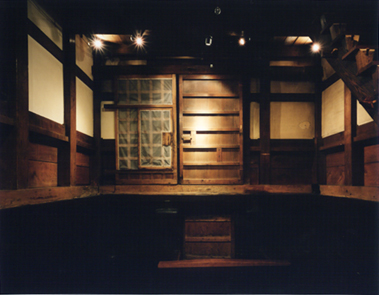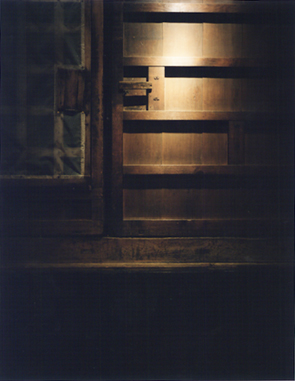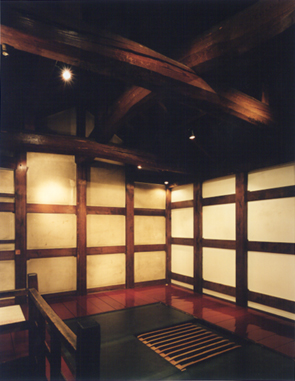Sumida River, which runs through the downtown of Tokyo, used to transport goods by ship before the modern road network was developed. This oldwarehouse is located in Asakusa, near Sumida River and was built in 1868. This warehouse was built by a family which was running a whole-sale lumber business. Their business flourished and became famous in Asakusa. They used this warehouse to keep their private property, not lumbers.
In 1923 an unprecedented huge earthquake destroyed Tokyo and in Asakusa most of the buildings were burned down. However the warehouse survived without any damage to its structure. And the end of World War ll, bombardment by the US Air Force had destroyed and burned down Tokyo again. Miraculously the warehouse survived yet again. It is very rare for such an old building to survive so long in Tokyo.
This warehouse was constructed with lumber made of Japanese cypress and pine trees, without any nails. The walls are made by plaster which is a mixture of lime, sea weed and flax. Originally high quality craftsmen, such as carpenters, plasterers and roof tilers were engaged in building this warehouse providing a strong and luxurious finish. Because of the family's wealth only the highest quality materials and craftsmen were used.
This building remains the embodiment of Edo architecture. It has also survived two great fires and constant re-development thus making it unique in this city.
In 1997 this warehouse was opened as an art gallery - Gallery éf. Many artists and craftsmen have gathered to transform this space, giving it a new lease of life.
ground floor L4750 / W3750 / H3410
floor design and
paint/ art direction of renovation:
Tsugio Nabeshima (Japanese lacquer artist)




1F L4830 / W3790 / H3400
floor design and
paint :
Machiko Fujisawa (Japanese lacquer artist)
Photo : Hideki Shiozawa

A week after the bomb attack during World War 2 on 19 March 1945. This photo was taken from the top of Matsuya Department Store. On the left is Sumida River and the small building in the middle is the warehouse - Gallery ef.

from same view point, 2006

An Encounter with the Sublime: Gallery éf and Its History
text : Aaron Michael Kerner ![]()
A lake of fire engulfed Tokyo; a judgment day to be sure, but at the hands of a mundane force. Like a flock of vengeful beasts, Allied bombers soared above the city; their lashing tongues ignited an inferno consuming everything, including the air itself. Nothing survived; suffocated or consumed by flames, the inferno leveled Tokyo: shelters were ineffectual, "as occupants died from suffocation or the effects of intense heat even when not exposed to fire itself."*1 Those that attempted to flee were asphyxiated by the hot gasses. A significant number of people instinctively ran to the canals or to the Sumida River only to be "literally scaled to death."*2
The inferno was indiscriminate all things lost form, lost structure, disintegrated, all things returned to dust. During the conflagration (March 9-10, 1945), the inferno created its own atmospheric flux producing gales up to 70 miles per hour. No one knows exactly how high temperatures rose, "but considerable" enough to melt "glass and, in one case, melted concrete."*3 An investigation of the stricken districts of Tokyo, Asakusa among them, because of the density of wooden structures and the density of the population revealed that not a single dwelling remained in the burned area. All combustible material was completely consumed. "The area was simply a mass of shattered tile, concrete static water tanks, and twisted steal."*4
Emerging from the dust and scorching ash, something auspicious and completely alien to the leveled charcoal colored landscape, the smoldering city; its cubic form - certainly not organic - strangely marked the horizon. Against all odds, as if the natural order of things had been cheated, what was to become Gallery ef stands. The structure itself - is just wood and earth - but nonetheless resisted the inferno's demand: "Return unto dust !" Opposed to the natural order and the monstrous inferno's drive, Gallery ef retained structure.
The opulent color field inside (now) - the light earthen hues matched with the warm and glistening lacquered blacks and reds - emphasizes the paradoxical character of Gallery ef. After-all the walls are merely earth - created from dust but never returning to an organic form - the lacquered floors at the core - organic, wood - resonate with their pristine gleam. All around Gallery ef a city was leveled, reduced to a monochromatic field, ash and dust, a vast field of gray, but Gallery ef retains its warm earthen hues and rich colored spectrum. Everything around it lost form, lost structure, Gallery ef ephemeral in character - consider the organic compounds of its structure - resisted the natural order, and its demand: "Return to dust !" Gallery ef is a monument to the meeting of the sublime, in the presence of the natural order - the lake of fire - it did not disintegrate, but it was enveloped into the sublime's infinite and undifferentiated universe of flowing particles; Gallery ef maintained its form and preserved its glorious edifice. In contrast to, or inspire of the abject terror of the Second World War (to which this structure bore witness), walking into Gallery ef transports the visitor to the domain of the sublime.
*1. "Effects of Incendiary Bomb Attacks on Japan: a Report on Eight Cities" vol. 10, The United States Strategic Bombing Survey (New York: Garland Publishing, Inc., 1976), 3.
*2. Ibid, 102. More people died in the Tokyo fire-bombings than at Hiroshima, at least from the intial effects of the atomic bomb. Between March 9 - 10, 1945, 85,793 people died in Tokyo, an additional 10, 179 people would die resulting from separate bombing raids. Between 60,000 and 70,000 people died due to the initial effects of the Hiroshima atomic attack. All figures presented here are from The United States Strategic Bombing Survey first published 1 July, 1946.
*3. Ibid., 94.
*4. Ibid., 97